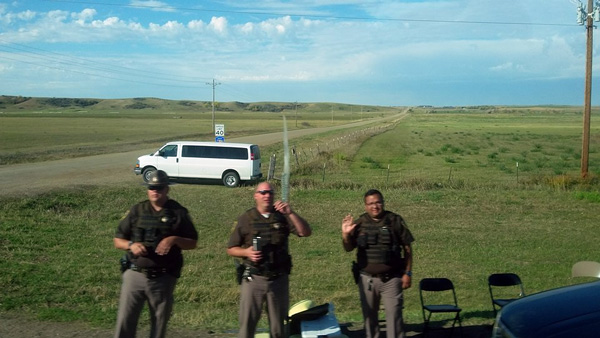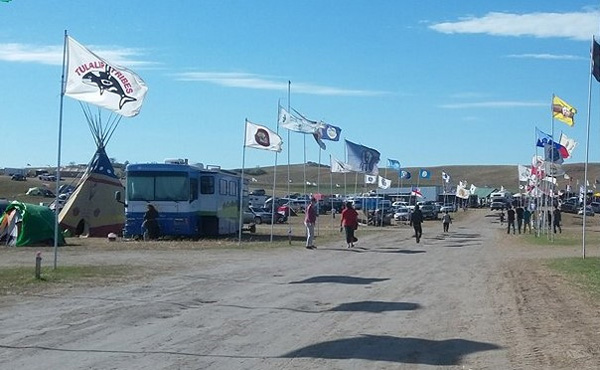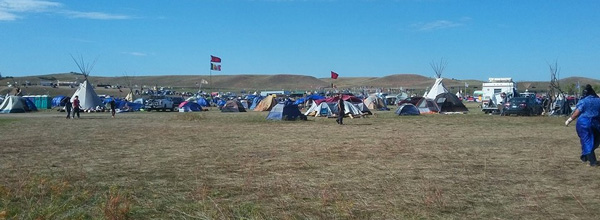Mni Wiconi





Over the past weekend my granddaughter, Athena and I visited Standing Rock Reservation, part of a group of 148 youth and adults who caravanned 500 miles to support the Lakota people. We were united to support clean water and to call out the Dakota Access Pipeline. “Mni wiconi, water is life” we chanted throughout the weekend.
Hundreds of tipis and tents, occupied by nations from across the land, were scattered over the Missouri River floodplain where the Hunkpapa Lakota nation had set up Sacred Stone camp. A steady stream of new caravans entered the camp daily. A double row of flags from a myriad tribes and places grew down the road, eventually curving around the access road above our own campsite.
Flapping and turning in the steady wind, we made out: Little Traverse Bay of Pechangayam Odawa, Riverside County CA; Kickapoo, Kansas; Tribes of Grand Rapids, Oregon; Reno-Sparks Indian Colony; Blackfeet- Pikuni; Potawatami- Forest County; Nooksack Indian Tribe; Cahto Tribe; Quinault Nation-Sherwood Valley; Bishop Paiute; Puyallup Tribe; Penobscot Indian Nation.
The last flag we had time to discern among the 100’s was Delaware-Lenape. In years past, information was scarce about the natives of the Schuylkill/Delaware River Valleys, the Leni Lanape: just that they had intermarried in the 1600’s with Finns who had come over with Swedes, and as a distinct people, no longer existed. How wonderful to see the Lenape flag!
And on our bus were Taino children. Many Puerto Ricans seem a mixture of African, Spanish and native, but decades past, no one talked about present-day Tainos. Only in books, we heard about Columbus’ genocide. To hear Yahaira, a teenage Taina, read at the main campfire a proclamation in solidarity with Standing Rock was music to the ears.
In the mere hours we were there, we met people from Germany and from Norway, and listened to a woman from the aboriginal nation of Yorta Yorta speak about mining that threatens her community in Southeast Australia. A Lakota woman from Sitka, Alaska gave our campers a blessing.
In addition to showing up to support clean water, our caravan brought 100-person winter tents with heaters and a contingent of Meshica (Aztec) dancers who wound their way through the camp to present at the main fire. Sponsored by Indigenous Roots and MN350, numbers of youth were just beginning an exploration of their native roots. A journalist from public television followed our steps, interviewing and filming.
Our mostly indigenous caravan was extremely welcoming, sharing tents, sleeping bags, food prep, and communal meals of vegetable soup and stew, chicken posole and egg and oatmeal breakfasts. The main camp shared bison and salmon feasts.
Athena insisted we attend a frontline meeting, where those experienced in demonstrations explained what to expect during an action at the Dakota Access dig site. Break-out groups learned blockade techniques, and how to respond if confronted by police. At this meeting, we met a woman from
New Mexico with a unique approach to life, believing that religions and governments will only work in the regions where they originated. “That is why Christianity won’t work in America, and why we need to convert back to the ways of Native nations,” she said. “For the sake of keeping a certain group in power, we, as a society, have been conditioned to believe that the way our government is set up is the only way of living.” This former North Dakota resident talked about the hate towards the native people across the Dakotas from people with my own roots, Norwegian and German settlers, and offered that people who emulate European ways should perhaps return to Europe.
The sweat lodge was intense, the night sky brilliant, the coyotes shrill. We offered tobacco and picked sage just before rolling home.
